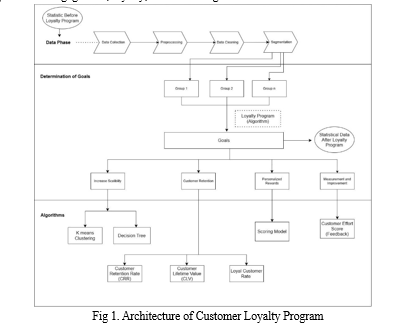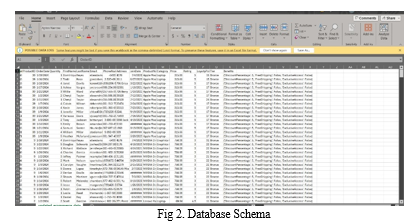Ijraset Journal For Research in Applied Science and Engineering Technology
- Home / Ijraset
- On This Page
- Abstract
- Introduction
- Conclusion
- References
- Copyright
Customer Loyalty Program: Enhanced Rewards and Insights for Lasting Engagement
Authors: Kranti Bade, Tejas Punde, Harsh Waghmare , Vignesh Naidu , Sajeev Chandran
DOI Link: https://doi.org/10.22214/ijraset.2024.59689
Certificate: View Certificate
Abstract
Customer loyalty programs are strategic initiatives designed to cultivate and maintain strong relationships between businesses and their customers. These programs offer incentives and rewards to encourage repeat purchases and foster brand allegiance. By leveraging various techniques such as points systems, tiered memberships, or exclusive perks, companies aim to enhance customer satisfaction and retention. Effective loyalty programs not only drive revenue but also provide valuable data insights into consumer behaviour and preferences. In today\'s competitive landscape, cultivating customer loyalty is paramount for sustained success, and loyalty programs serve as powerful tools in building enduring connections with clients.
Introduction
I. INTRODUCTION
In today's highly competitive business landscape, customer loyalty programs have emerged as a vital tool for companies seeking to retain and cultivate long-lasting relationships with their customers. Customer loyalty programs aim to incentivize customers to make repeat purchases and engage with a brand consistently. By offering rewards, discounts, or exclusive benefits, these programs foster a sense of belonging and appreciation, enhancing the customer's connection to the brand. In turn, this fosters customer retention, increasing the customer's lifetime value to the business. Customer loyalty programs have evolved into a strategic tool that contributes to a company's overall success. They not only boost customer retention but also drive revenue growth, strengthen brand affinity, and provide valuable customer data for future business decisions. A customer loyalty program is essential for businesses seeking to build and maintain strong, lasting relationships with their customer base. In today's highly competitive marketplace, where consumers have a plethora of options, such programs provide a critical incentive for customers to keep coming back. By offering rewards, discounts, or exclusive perks to loyal customers, businesses can not only encourage repeat purchases but also create a sense of belonging and appreciation among their clients. This sense of loyalty fosters trust, which, in turn, can lead to positive word-of-mouth marketing, increased customer retention, and higher lifetime customer value. Additionally, loyalty programs offer valuable insights into customer behaviour and preferences, enabling businesses to tailor their offerings and marketing strategies more effectively. Programs are not just about offering discounts or freebies; they serve as integral components of a company's overall business strategy. By fostering loyalty among their customer base, businesses can drive repeat purchases, increase customer lifetime value, and ultimately boost profitability. Moreover, loyal customers are more likely to act as brand advocates, spreading positive word-of-mouth and attracting new customers through referrals. This organic growth can significantly reduce customer acquisition costs and contribute to sustainable business growth in the long run. The existing customer loyalty program in place faces several challenges. While it provides some basic incentives for repeat purchases, it lacks personalization and fails to fully engage customers. The rewards structure is often generic and doesn't effectively target individual customer preferences and behaviors. Moreover, the program's communication and marketing strategies are limited, making it challenging to inform customers about the program's benefits and maintain their interest. The lack of robust data utilization and clear KPIs also hampers the ability to measure the program's impact on customer retention and overall business growth. In essence, the current system falls short in creating a compelling and differentiated loyalty program that can effectively enhance customer loyalty and contribute to the company's long-term success.
II. REVIEW OF LITERATURE
Numerous studies have examined the effectiveness of loyalty programs in driving customer loyalty and repeat purchase behaviour. Numerous researchers have introduced the concept of the "loyalty effect," suggesting that increasing customer retention rates by even a small percentage can lead to substantial improvements in profitability. Additionally, studies found positive correlations between participation in loyalty programs and increased customer spending and frequency of purchase. Several factors have been identified as critical determinants of the success of loyalty programs. These include program design elements such as the structure of rewards, simplicity of redemption processes, and alignment with customer preferences.
A paper describing [1] in this research papers, the general purpose of this study is to identify, describe and analyse elements that have an impact on understanding customer loyalty or disloyalty. We need to investigate how is the customer loyalty degrees and types. The behavioural and attitudinal tendency of a customer is not consistent.
We need to distinguish such different loyalty types. Furthermore, the factors which lead to loyalty or disloyalty need to be uncovered and understood before designing and implementing the strategies for customer retention and loyalty. Therefore, we analyse the customer loyalty at a fine-grained level and define a 5-tuple.
The study from [2] suggests applying Bayesian inference to the Net Promoter Score (NPS), a commonly used measure of Customer loyalty. It proposes Bayesian model using minimum distribution for customer responses. It proposes Bayesian model using multinomial distribution for customer responses, Dirichlet prior for NPS. Robust statistical framework for customer loyalty estimation. The authors aim to provide point and interval estimators for the NPS and address the sample size determination problem, which has not been adequately studied in previous literature sequences stored on the computer. The paper approach appears to be based on specific idea about the underlying distribution of customer responses and the prior distribution of parameters. This can be a useful tool for demonstrating the idea, it might raise concerns about the application and real-world relevance of the findings.
Another study [3] focuses on the researchers using various technologies and strategy including Product Cost Asymmetry, Price Discrimination, Markov equilibrium, Customer Segmentation, Dynamic Pricing, Personalized Pricing.To determine how price discrimination can lead to higher profits for firms and how firms can tailor their price changes strategies extract Maximum value from loyal customer. Additional related prior works. Provides justification for assumptions. Analyses the infinite horizon setting when firms are myopic. Determining the optimal pricing strategy accurately segmenting customers based on loyalty and willingness to pay can be difficult. The study [4] highlights the objective of this project is to develop privacy preserving digital punch card protocols that replicate the functionality of traditional physical punch cards used for customer. The project aims to balance computation, storage, and Privacy effectively. Fixed size wallets prevent storage growth with more punches, aiding stability. Server Setup: The loyalty program server creates its public and secret keys. An empty database is established to track redeemed punch cards. Punch card secret is created to represent loyalty points. At its core, a customer loyalty program is a structured approach employed by businesses to reward and retain their existing customers. Through a variety of incentives, rewards, and exclusive offers, these programs seek to incentivize customers to choose a particular brand consistently over its competitors. Whether it's through points-based systems, tiered memberships, cashback rewards, or special discounts, the underlying principle remains the same: to enhance customer satisfaction and deepen their emotional connection with the brand. Recognition. The table displays accuracies obtained using each trained CNN, including images generated through augmentation techniques.
III. METHODOLOGY
A Customer loyalty program is a structured marketing initiative designed to reward and incentivize customers for their repeat patronage and engagement with a brand or business. These programs are founded on the principle that a loyal customer not only provides consistent revenue but also becomes a brand advocate, spreading positive word-of-mouth and enhancing the company's reputation.
A. Research and Analysis
- Conduct market research to understand customer preferences, behavior, and expectations.
- Analyze existing data on customer transactions, interactions, and feedback to identify trends and patterns
- Segment the customer base based on demographics, purchasing history, and other relevant criteria.
B. Program Design
- Define the objectives and goals of the loyalty program, aligning them with the overall business strategy.
- Determine the structure of the program, including the types of rewards, point systems, and tiers.
- Select the appropriate technology platform or software solution to support the program's implementation and management.
C. Feature Selection
- Choose the features and incentives to include in the loyalty program, considering factors such as customer preferences, industry standards, and budget constraints.
- Offer a variety of rewards, including discounts, free products or services, exclusive access, and personalized offers
- Design a user-friendly interface for customers to track their progress, redeem rewards, and engage with the program.
D. Implementation
- Develop a timeline and roadmap for implementing the loyalty program, outlining key milestones and deliverables.
- Collaborate with cross-functional teams, including marketing, sales, and IT, to ensure seamless integration with existing systems and processes
- Train employees on the program's features, benefits, and customer interaction protocols.
- Conduct a soft launch or pilot test to identify any issues or areas for improvement before rolling out the program to a wider audience.
E. Communication and Promotion
- Create a comprehensive communication strategy to promote the loyalty program to existing and potential customers.
- Utilize multiple channels, including email, social media, in-store signage, and website banners, to reach target audiences.
- Develop engaging and persuasive messaging that highlights the value proposition of the program and encourages participation
- Monitor customer feedback and adjust communication tactics as needed to optimize engagement and retention.
F. Monitoring and Optimization
- Implement tracking mechanisms to monitor the performance of the loyalty program in real-time
- Analyze key metrics such as enrollment rates, redemption rates, and customer satisfaction scores to assess program effectiveness.
- Identify areas of improvement based on data insights and customer feedback, making adjustments to the program as necessary.
- Continuously optimize the program to adapt to changing market dynamics, customer preferences, and competitive pressures.
G. Evaluation
- Evaluate the overall impact of the loyalty program on business objectives, including revenue growth, customer retention, and brand loyalty.
- Compare actual outcomes with predefined goals and benchmarks to assess program success.
- Solicit feedback from customers and stakeholders to gain insights into their experiences and satisfaction levels
- Use evaluation findings to inform future iterations of the loyalty program and drive continuous improvement.
This methodology outlines a systematic approach to developing, implementing, and evaluating your loyalty program, ensuring its effectiveness in driving customer engagement, loyalty, and business growth.


Conclusion
In conclusion, the customer loyalty program has yielded a range of positive outcomes, from customer retention and engagement to revenue growth and the collection of valuable customer data. These conclusions demonstrate the program\'s effectiveness in building strong customer relationships and providing a competitive edge in the market. The data and feedback gathered will continue to inform ongoing improvements and the evolution of the program to meet changing customer needs and market dynamics. One of the primary conclusions is the increase in customer retention rates. The loyalty program has proven to be an effective tool in retaining existing customers. Participants are more inclined to stay loyal to the brand, resulting in reduced churn and a more stable customer base. This is evident in the declining attrition rates and the continued patronage of loyal program members. The program has had a profound impact on customer engagement. Participants are more actively involved with the brand, leading to increased interaction, repeat purchases, and a deeper connection with the company. Metrics like click-through rates, response to promotions, and participation in program-related activities demonstrate this heightened engagement. A noticeable positive conclusion is the impact on sales and revenue. The loyalty program has been instrumental in driving increased sales and revenue. Participants not only make more frequent purchases but also tend to spend more on each transaction. This is reflected in the program\'s contribution to the company\'s bottom line. The loyalty program has served as a channel for collecting valuable customer feedback. The feedback loop is active, enabling the company to understand what customers appreciate and areas where improvement is needed. This feedback mechanism has become a valuable resource for continuous program enhancement. Building stronger customer relationships was a primary goal of the program, and it has been achieved. Customers participating in the program feel more valued and appreciated by the brand. These improved relationships are reflected in positive feedback, reviews, and the quality of customer interactions.
References
[1] Yiou Wang, Tahara Takuji, A Japanese Corpus for Analyzing Customer Loyalty Information, 2023 IEEE Xplore. [Online]. [2] Mr. Eliardo G. Costa, Rachel Tarini, \"Bayesian Inference for the Net Promoter Score 2023\" IEEE Xplore. [Online]. [3] Theja Tulaban Dhula, Aris Ouksel, Son Nguyen\" Price Discrimination in the Presence Of Customer Loyalty and Differing Firm Costs,2022,\" IEEE Xplore. [Online]. [4] Saba Eskandarian, “Fast Privacy Preserving Punch Cards”, 2021 [Online]. [5] Rosalind McMullan, Audrey Gilmore “Customer Loyalty: An Empirical Study”, 2008 [Online]. [6] Magdalena Hofman-Kohlmeyer, “Customer Loyalty Program as a Tool of Customer retention”, 2016 [Online]. [7] Zhibin Lin, Dag Bennett, “Examining retail customer experience and the moderation effect of loyalty programmes”, 2014 [Online]. [8] Elena Cedrola, Sabrina Memmo, “Loyalty marketing and loyalty cards: a study of the Italian market”, 2010 [Online].
Copyright
Copyright © 2024 Kranti Bade, Tejas Punde, Harsh Waghmare , Vignesh Naidu , Sajeev Chandran . This is an open access article distributed under the Creative Commons Attribution License, which permits unrestricted use, distribution, and reproduction in any medium, provided the original work is properly cited.

Download Paper
Paper Id : IJRASET59689
Publish Date : 2024-03-31
ISSN : 2321-9653
Publisher Name : IJRASET
DOI Link : Click Here
 Submit Paper Online
Submit Paper Online

